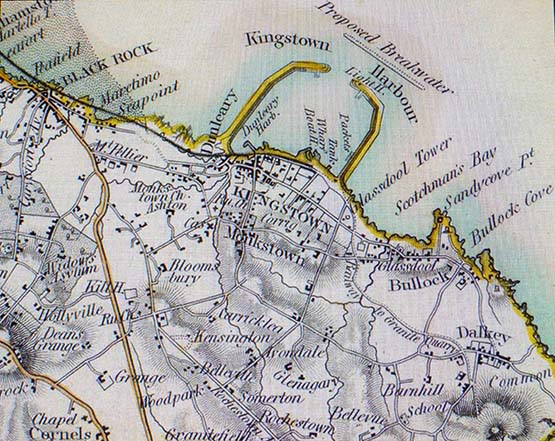Displaying items by tag: Dublin Port
Milestone for Irish Rail and IWT Dublin Port-Ballina Intermodal Service
#PortRailFreight - Iarnród Éireann and International Warehousing and Transport (IWT) reached a milestone as their partnership that transports intermodal containers and tanks by rail from Dublin Port to Ballina, Co. Mayo reached the 1500th train to operate during November.
According to MultiModal, six years ago the service commenced with just two trains per week from Dublin North Wall and the equivalent return services from Ballina.
Trains at Dublin Port were then being loaded on the Alexandra Road tramway until in May 2011 as previously reported on Afloat.ie the bespoke rail terminal at the port opened and services were transferred into it.
Over the intervening years the demand for the services steadily increased with up to 16 services now being operated each week. Use of rail has helped Ireland towards meeting its emissions targets with approximately 24,000 truck movements being saved from the roads and a saving of close to 5 million kgs in Co2 emissions being achieved.
Planned developments for these services include longer trains on the Dublin-Ballina route to improve the competitiveness of rail versus road. Co. Mayo is a major freight hub on the Iarnród Éireann network and in the latter part of 2015 sidings at Claremorris have been relayed and extended with one additional track being brought back into use to cope with the levels of freight now running to and from the county.
In addition to the IWT trains, pulpwood trains are operated regularly for Coillte, the Irish timber company and intermodal trains for DFDS Logistics. There are high hopes that a contract for further freight in the form of biomass will also be secured during the coming year.
Opposition to €20m Aviation Fuel Pipeline Planned to Dublin Airport
#OppositionFuelPipe - Residents living in Dublin along the route of a planned €20m aviation-fuel pipeline to Dublin Airport have raised safety concerns, according to yesterday's Irish Examiner.
Last month, Dublin City Council gave the green light to Fingleton White Ltd for the 11km section of the pipeline that passes through city council territory.
In June, Fingal County Council granted planning for the remaining 3km of the pipeline, which commences at Dublin Port.
The Fingal decision wasn’t appealed to An Bord Pleanála, but three appeals have been lodged by parties against the City Council decision, with the board ruling out a fourth appeal, lodged by Deputy Tommy Broughan, on a technicality.
Fingleton White say that the fuel demand at Dublin Airport results in 15,000 tanker journeys a year to Dublin Port and that a UK study has concluded “that the operation of the proposed pipeline has a significantly lower level of risk”.
The newspaper has more coverage here.
Marine Pilot Vacancy At Dublin Port
#Jobs - The Dublin Port Company invites applications from marine pilots for inclusion on a panel from which future permanent and temporary vacancies in the Dublin Pilotage Service will be filled.
The panel will be active for a period of two years. Applicants must be a holder of a valid STCW Level A-II/2 certificate of competency and must have extensive ship-handling experience.
The closing date for applications is Friday 4 December 2015. Details on how to apply are available on the Dublin Port website HERE.
Dublin Port Wins 2015 ESPO Award on Societal Integration of Ports
#2015ESPOaward - Dublin Port has been awarded the 2015 ESPO Award on Societal Integration of Ports in recognition of its strategies in making schools and universities aware of their local port and its activities. The award was presented last night at a ceremony held in Brussels.
In 2009 the award was established to promote innovative projects of port authorities that improve societal integration of ports, especially with the city and wider community in which they are located.
The theme of this year’s ESPO Award was Engagement with local schools and universities. Dublin Port Company won the 2015 Award for its project, Port Communities Educational Support Programme, which helps increase employment options within the disadvantaged communities that provided the port’s workforce in the past.
The programme includes Early Learning Initiatives, Technology in schools, Scholarships Programme and support to sport teams. The educational programme is a response to when port communities in Dublin have been impoverished by the great reduction in employment opportunities caused by the industrialisation of cargo handling beginning in the 1960’s with the growth of unitised freight.
Eamonn O'Reilly, Chief Executive, Dublin Port Company said "We are delighted in Dublin Port to have our efforts engaging with local schools and universities recognised by ESPO. The ESPO Award is a prestigious recognition by our peers in the port industry across Europe of our efforts in Dublin to achieve a greater unity between the port, the city and local communities through the medium of education. I have always been impressed by the quality and the number of submissions for the ESPO awards and for Dublin to be recognised this year is a tremendous endorsement."
The Chief Executive added "It is also a great motivator for us to continue to work more generally to achieve the objectives of ESPO's Code of Practice on Societal Integration of Ports.To win the ESPO Award 2015 is very much a case of primus inter pares."
Timelapse Video Of Dublin Port Diving Bell Restoration
#DublinPort - The Dublin Port Company has posted this incredible timelapse video of the four-month restoration of the capital's 129-year-old diving bell.
As previously reported on Afloat.ie, the Docklands mainstay opened as Dublin's newest tourist attraction this past July, with interpretive panels detailing its use in the construction of the Liffey quay walls from the late 19th century till the 1950s.
Its original designer, Bindon Blood Stoney, was also the engineer responsible for such landmarks as O'Connell Bridge and the Boyne Viaduct bridge in Drogheda.
Still having pride of place on Sir John Rogerson's Quay, the diving bell is now elevated an extra two metres allowing access for the public underneath.
Dublin Port's Educational Programme Shortlisted for EPSO Award
#EPSOshortlist - This year’s European Sea Ports Organisation (ESPO) Award celebrates the role that ports can play in demonstrating the best strategies in making schools and universities aware of their local port and its activities.
The five ports shortlisted for this year’s Award, Antwerp, Bremen, Dublin, Guadeloupe and Valencia all succeed in creating the interest of the local schools and universities in the work of the port.
ESPO is proud to present the shortlisted projects among them Dublin Port's community educational support programme before the winner is announced at a ceremony at the Albert Hall in Brussels on 10 November.
An Bord Pleanala is currently in process of hearing submissions - for and against - about the future of a proposed superliner berth in Dun Laoghaire which would change the harbour out of all recognition for recreational purposes, but could provide Dun Laoghaire Harbour Company with a new income stream, though only after massive investment.
Meanwhile, Dun Laoghaire/Rathdown County Council agreed on October 22nd in a requirement of their Development Plan that the harbour – which they will control in the future if proposed legislation can be completed and put in place – will be limited to berthing liners of not more than 250 metres in length. W M Nixon returns this morning to the continuing saga of Dun Laoghaire Harbour’s future.
It was only a snippet of news in the stream of maritime information which pours steadily through the Afloat.ie website, no more than a Tweet from Cllr Melissa Halpin on October 22nd confirming the 250 metre length limit’s approval. She was responding to Afloat’s review of ideas in an Opinion piece in The Irish Times by Dermot Reidy of Dun Laoghaire Combined Clubs, an active umbrella group which has put forward a detailed submission to An Bord Pleanala. And the DLCC’s proposals, as Councillor Victor Boyhan was delighted to report yesterday, also received the full support of the Council at their weekly meeting, this time on Thursday, October 29th. [see webcast of Special Meeting of the County Council on the Development Plan here – Ed]
The oral hearing will resume for its final public session on Monday 2nd November after taking a week’s break from October 23rd following the hearing of detailed submissions from many sources since October 14th. But it was typical of the way that so many organisations are involved – or would wish to be involved – in the future of Dun Laoghaire Harbour, that even as An Bord Pleanala was still taking evidence, the local council finally responded to the growing pressure from the Save Our Seafront group led by local politicians such as Richard Boyd Barrett TD and Cllrs Melissa Halpin and Victor Boyhan, and considered a motion to restrict the size of cruise liners which will be allowed to use Dun Laoghaire Harbour in the future.
It could be that it’s only a straw in the wind, for as Richard Boyd Barrett so tellingly explained to the hugely-significant protest meeting in the Kingston Hotel on September 7th, while there is a Government aspiration to transfer control of the administration of Dun Laoghaire Harbour to the local council, various legislative sleights-of-hand and some political and business manoeuvrings could still mean that in the end, the Dun Laoghaire Harbour Company’s commercial imperatives – real or imagined – could be the final controller of the agenda, with Dun Laoghaire/Rathdown County Council only in titular control.
Nevertheless, the DL/RCC’s new Development Plan’s inclusion of the stipulation that cruise liners coming to the harbour should not exceed 250 metres in length is a huge improvement on the unlovely 360 metre floating tenements which are currently envisaged in the Harbour Company’s plan. And when we actually get around to considering the sort of ship this will involve, and how she can be accommodated at a re-configured version of either St Michael’s Wharf or Carlisle Pier without any intrusive new structures in mid-harbour, then we realize we are indeed looking at something hopeful.

Photo imaging of a maxi-size 360 metre cruise liner in the proposed berth in mid-harbour in Dun Laoghaire, which would involved building a new 435 metre pier jutting far into what is currently clear water.
There are many 250 metre modern high quality cruise liners afloat today, and they occupy a sweet part of the upper end niche market which would provide the possibility of bringing Dun Laoghaire the kind of discerning cruise line passengers who might do the local economy a bit of real good over and above the basic income paid to the Harbour Company as berthing fees.
But by contrast, in the case of a giant liner of 360 metres, the berthing fees are pretty much the only income that will accrue to the local economy, as tenement cruise liner folk are not big spenders ashore, in fact many of them plan to do their entire cruise without spending one cent extra on the money they laid out to buy their ticket in the first place.
Such giant ships can be comfortably, conveniently and economically accommodated in Dublin Port, where the European Development Bank has just approved a €100 million loan to further develop the giant cruise liner berthing. All of which makes it even more absurd that Dun Laoghaire Harbour Company should be thinking of hunting in the same over-fished pool, when there is a different and well-stocked pool for which their harbour and town’s unique appeal will provide a juicy and successful bait.
And on top of that, for our maritime enthusiasts, setting the length limit at 250 metres is something very special, for it takes us right into consideration of one of the finest ships ever built in Ireland - the wonderful Canberra, the last and possibly the greatest ocean liner ever built by Harland & Wolff in Belfast. She may have been launched as long ago as 1958 – on St Patrick’s Day, no less – yet although she ended her active and very varied career in 1997, she still looks as modern as tomorrow, and her handy overall length of 250 metres – 820ft since you ask – made her ideal for a cruise liner to interesting places after she’d been taken off her original route from London to Australia.
The Canberra
She also served as a troopship in the Falklands War of 1982, where her duties included a visit to South Georgia where she would have been anchored close to Sir Ernest Shackleton’s grave. But eventually, after many years of further popular service as a cruise liner, for all that much of her technology was way ahead of its time, the poor old Canberra just got worn out, for she’d been busy since the day she left Belfast Lough – and in 1997 she was sold to Pakistan to be scrapped on the beach, which she resisted to the end – the word is this unique vessel took an awful lot of breaking up.

The hard life. Canberra in South Georgia while on troopship duties during the Falklands war of 1982
Invitably, modern 250 metre cruise liners do not quite have the timless elegance of the Canberra, as accountants and financial officers rule their concept as much as naval architects. But nevertheless they are of a more comprehensible and manageable size than the excessive 360 metre behemoths which would destroy the character of Dun Laoghaire Harbour, and provided the Harbour Master felt it could be done without impairing the basic character of the harbour, I feel we should be at least receptive to the idea of 250 metre vessels coming in, for it’s a huge step for the County Council to have made the decision to set this size limit.
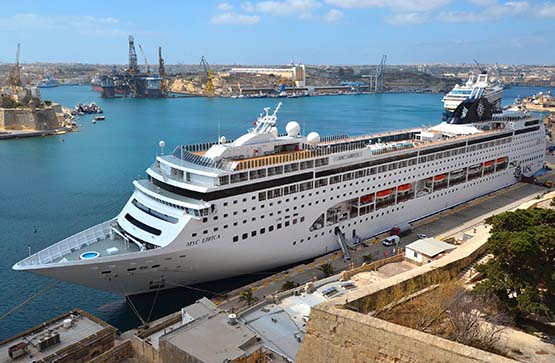
The Lirica is a modern 250 metre cruise liner, and although obviously more voluminous than Canberra, nevertheless it is possible that she could be berthed in Dun Laoghaire without massive waterfront infrastructural change being required.
Meanwhile, the battle goes on to try and create a truly meaningful relationship between Dun Laoghaire township and its harbour, for as we’ve pointed out here before, when they started planning an Asylum Harbour back in the early 1800s, it was moved forward primarily by considerations of facilitating government power and function, and there was no real consideration of the requirements of ordinary mortals.
Thus the most basic initial thinking behind the new harbour was that it could provide refuge when required for troopships and naval vessels. So no thought whatever was given to the notion that personnel on board such vessels should have any contact with the shore, which at that time was virtually empty in any case, as the only local settlement of any kind, the little harbour of Dun Leary, was seen as being outside and irrelevant to the new harbour.
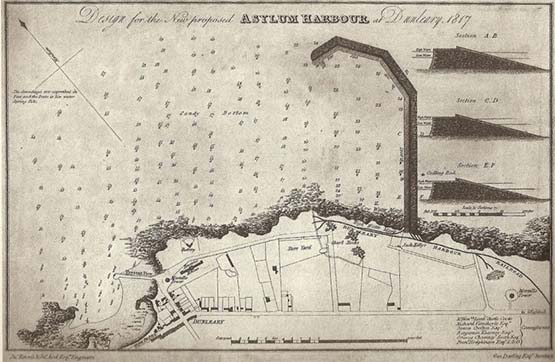
The beginnings. The initial plan for the new Asylum Harbour was a singe pier to provide protection from southeasterlies. It was well to the east of the little local port of Dun Leary, and a new road – ultimately George’s Street - was sketched in through uninhabited countryside to take travellers direct from Dunleary to the next local village of Dalkey while keeping them at some distance from the new harbour
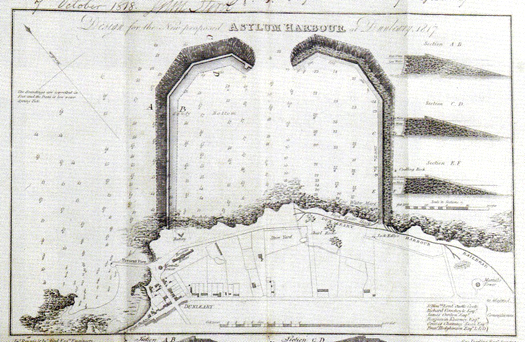
A second plan for the new harbour included a west pier, but it still excluded Dunleary itself.
But as the new harbour took shape, superbly constructed in Dalkey granite to be a sort of “instant historic monument”, inevitably shoreside development took place as well. After the place had been named Kingstown following a Royal Visit in 1821, it got notions of itself as a fashionable resort. But it was a case of every man for himself in the matter of development, and as one scathing critic wrote of in the 1850s, “ no system whatever has been observed in laying out the town so that it has an irregular, republican air of dirt and independence, no man heeding his neighbour’s pleasure, and uncouth structures in absurd situations offending the eye at every turn”.
Kingstown and its harbour around 1870, with a proposed breakwater (never built) off the entrance to provide added shelter from nor’easterlies. The railway still only reached halfway along the waterfront, and the Carlisle Pier had yet to be built, with the cross-channel packet boats having to make do with a berth on the East Pier.
Could that possibly be our own dear Dun Laoghaire? That reference to a “republican air of dirt and independence” was particularly hurtful to a place which prided itself on being called Kingstown, but that’s the way it was and still is, for the fact of the matter is that while the town and harbour have developed side by side, they have never developed together.
Thus there are enormous blind spots to the interests of others. The new library may look not too bad at all from the landward side, but from the harbour it is hideous. As for the endless struggle to make George’s Street back into a successful retail shopping venue, no matter what they do it still seems to slip further down the decline, and the recent plan to sub-divide it into quarters devoted to different area of shopping interest made no reference at all to the potential of the nearby presence of the harbour, for apparently that had not been in the consultants’ brief.
As for paying for the running of the harbour, we recently got an old friend, an accountant with a maritime outlook and extensive experience in many countries, to take a look at Dun Laoghaire in its totality and how the harbour might be funded, and he concluded that trying to find out how much it actually costs to run the harbour in some sort of relationship with the town would be like being eternally condemned to peeling an onion, as one layer removed would only reveal another, and you’d ultimately be reduced to tears.
That said, he did make us sit up and take notice by suggesting that they’re wasting their time trying to revive George’s Street as a shopping venue – instead, they should think in terms of letting it become residential with some offices in a setup which would thereby encourage a few thriving local shops at strategic intervals, rather than trying to have a whole row of under-utilised shops in terminal decline with the street’s decreasing footfall.

The Carlisle Pier in its glory days, when it was possible to get into a train in Sligo and travel all the way to London without being exposed to the rain at any stage. And of course, there was no question of spending any money in Kingstown……
Today, people talk about the situation of Dun Laoghaire Harbour as if it was always the case that it was a commercial and ferry port, and that the modern administrators of the port are obliged under time-honoured traditions to show a profit. In fact, Dun Laoghaire started life as Royal Harbour serving governmental and imperial needs, and ordinary people trying to do something so vulgar as make a living and even show a modest profit had to do so under the radar.
Thus although “ferry port” is still the link which will most readily spring to public mind in relation to Dun Laoghaire, but the early ferry operators had to get by as best they could with ad hoc facilities, and even a seemingly ancient structure such as the Carlisle Pier, with its two cross-channel ferries directly serviced by the railway, was a later addition – for many years, the best the packet boats could hope for was the berth on the east pier.
So contemporary letters to the newspapers which assert that Dun Laoghaire must now develop further and pay for itself, because it would not be in being were it not for Victorian entrepreneurial flair, are actually very wide of the mark. There was nothing at all entrepreneurial and commercial about the original thinking behind the building of Dun Laoghaire Harbour. So it would be in keeping with its true character and history were it allowed to be maintained today as a sort of maritime version of the Phoenix Park.
But of course, if 250 metre cruise liners really could be slotted in without requiring drastic changes to the waterfront, then well and good. And as we came in with a discussion about the last and best ocean liner built in Belfast being 250 metres long, how’s about the most famous ocean liner ever built in Belfast? It’s said that some mysterious billionaire is having a replica of the Titanic built in China. As it happens, the original Titanic was 269 metres long. But if the new Titanic expressed an interest in berthing in Dun Laoghaire, surely those extra 19 metres could somehow be accommodated………
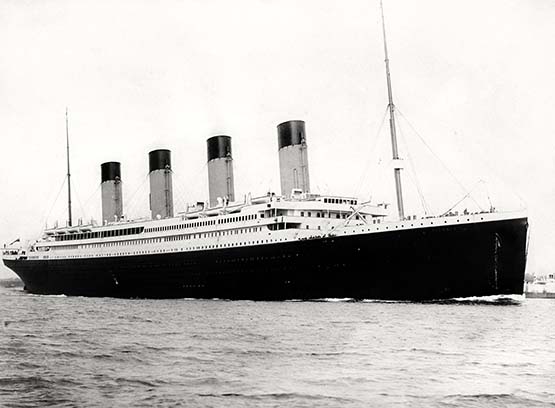
Would they allow those extra 19 metres into Dun Laoghaire? It’s rumoured that a replica of the Titanic is being built in China, but at 269 metres they’d have to stretch the regulations a little to let her into Dun Laoghaire Harbour.
Dublin Port on Track for Record Year & 60m Tonnes of Cargo by 2040
The Vice President of the European Investment Bank (EIB), Jonathan Taylor, will today meet with Dublin Port Company representatives to finalise financing arrangements for Dublin Port’s Alexandra Basin Redevelopment (ABR) Project. The Minister for Transport, Tourism & Sport, Paschal Donohoe, T.D. will also be in attendance to discuss Ireland’s long-term infrastructure development plans.
The EIB has committed to providing a €100m loan amortising over 20 years, reflecting the long-term nature of the ABR Project. This is the first time in 20 years for the EIB to finance port infrastructure development in Ireland and highlights the strategic significance of the project, which has a grant of planning permission from An Bord Pleanála. The largest single infrastructure development project in the history of Dublin Port, Dublin Port’s ABR Project is expected to take five years to complete, costing an estimated €230 million. An analysis by Indecon International Economic Consultants of the wider economic impacts arising from the ABR Project found that for every €1 million in economic costs, the project is associated with €2.80 million in economic benefits.
Today’s meeting comes as trade volumes continue to rise at Dublin Port in line with projections for a record year in 2015. New figures show total throughput (imports and exports) for the year to 30th September was 24 million gross tonnes, an increase of 5.8% on the 23 million tonnes handled in the first nine months last year. Showing further improvement in the domestic economy, imports rose 6.0% to 14.4 million gross tonnes on the same trading period, while exports strengthened by 5.5% to reach 9.9 million gross tonnes.
Eamonn O’Reilly, Chief Executive, Dublin Port Company, said: “It is clear now that 2015 will be a record year and that yet more growth will come in future years as Ireland’s economy recovers. The strong growth on the import side and, within this, the 8.2% growth in petroleum imports from 2.7m to 2.9m tonnes and the 12,000 additional cars imported in the first nine months all come from the welcomed recovery in the domestic economy.”
Unitised trade grew across both Ro-Ro and Lo-Lo modes. When compared to the same nine months last year, Ro-Ro trailers pushed ahead by 6.6% to 650,104. The port’s Lo-Lo container business, which had been the worst affected cargo mode during the downturn, continues to recover strongly, and is up 8.0% to 452,992 TEU. The growth in unitised business follows increased passenger and freight sailings to and from Britain and Continental Europe, confirming Dublin Port as the island’s port of choice for Ro-Ro and Lo-Lo services.
New car and commercial vehicle imports continued apace with over 70,000 (70,483) new vehicles imported through Dublin Port in the first nine months of the year, up 20.7% on the same period last year. On the tourism side, over 1.4 million ferry passengers passed through Dublin Port in the first nine months of the year, up 6.3% on the same period last year. The figures reflect strong growth in passenger numbers travelling to Britain and France for holidays during peak season.
There was an 11.3% increase in the number of cruise ships calling at Dublin Port in the first nine months of the year with 89 cruise liners bringing almost 100,000 (98,253) high spend passengers to the capital to date. The third quarter included the arrival of four luxury cruise ships carrying 13,000 passengers in a single day. With Dublin Port’s cruise season extending until December and further cruise calls scheduled, the company’s forecast of a record cruise season remains firmly on track.
Eamonn O’Reilly, Chief Executive, Dublin Port Company, said: “Dublin Port welcomes today’s visit by the Vice President of the European Investment Bank as we finalise arrangements for €100m financing for the Alexandra Basin Redevelopment Project. This is the next step to commencing work on the project, having already secured permission from An Bord Pleanála. Against a background of strongly growing trade, the availability of long term and well-priced finance is essential to allow us to invest in the port capacity needed in the future. We do not have spare capacity in the port and it is essential that we stay ahead of the growth with essential investment in port infrastructure. The long-term support of the EIB is just what we need.”
Jonathan Taylor, European Investment Bank Vice President, said: “Investment to upgrade Europe's key ports is essential to improve transport logistics and reduce transport costs passed onto consumers. The Port of Dublin is a crucial transport hub for Ireland and the European Investment Bank looks forward to supporting redevelopment of the Alexandra Basin. This reflects our firm commitment to supporting transport schemes across Ireland such as the M11 road upgrade announced last week and Luas cross city connection currently being built.”
Minister for Transport, Tourism & Sport, Paschal Donohoe, T.D., said: “As a Tier 1 port of national significance, Dublin Port has a strategic role in supporting economic recovery and facilitating future growth. Today’s meeting with the EIB Vice President and commitment to €100m financing for Dublin Port’s ABR Project is significant. It represents confidence in Dublin Port to handle 60 million tonnes of cargo by 2040 and fulfil its mandate of operating an efficient, well-resourced port that can facilitate Ireland’s trading needs.”
“I commend Dublin Port Company on its long-term vision and prudent financial planning to realise the project with the support of EIB. Government’s Capital Plan similarly takes a long-term approach to infrastructure investment and includes an allocation of almost €10 billion from my Department to prioritise the development of our transport network and facilitate a growing economy.”
Hollywood Star's Former Yacht Berths In Dublin
Dublin Port’s Vintage Rally Returns
The Dublin Port Rally supported by Dublin Port Company returns for a second year running following the roaring success of last year’s inaugural event which attracted over 220 vintage vehicles and 3,000 spectators in a single day.
The Minister for Transport, Tourism and Sport, Paschal Donohoe, TD, will officially open the vintage vehicle extravaganza on Saturday, 26th September at 1pm, kick-starting this growing fixture on Ireland’s event calendar which will appeal to motor enthusiasts, families and anyone with an interest in Ireland’s transport history.
This year’s rally has expanded to take place over two days, 26th and 27th September 2015, from 12pm to 6pm each day at Dublin Port. On show will be an impressive array of beautifully maintained and rarely seen classic buses, vintage trucks, vintage and classic cars, as well as veteran fire and military vehicles.
The event is also a celebration of the 70th anniversary of the foundation of CIE in 1945. Stars of the show include vintage buses and trucks which chart the history and development of CIE down through the years, and are sure to bring back memories for former bus drivers and conductors, mechanics and passengers alike. Highlights include a recently restored 50 year old CIE double deck bus which will be officially unveiled by the Minister.
Visitors can also hop on vintage guided bus tours of Dublin Port itself, pick up transport memorabilia from a host of vendors, and stop for a chat and cuppa at the vintage bus café and other food outlets on site, while the kids enjoy the play bus and model exhibitions.
Access to the event is recommended via the LUAS Red Line to The Point, just 200 metres from the event venue on Alexandra Road, Dublin 1. For admission prices and further details: www.dublinportrally.com
Eamonn O’Reilly, Chief Executive of Dublin Port Company, said, “We are delighted to host the Dublin Port Rally for a second year running. This year’s event has something for everyone, including vehicle enthusiasts, local historians, visitors and families. Wherever your interest lies, this is a fantastic opportunity to see some of Ireland’s best kept vintage vehicles up close and I would encourage everyone to come along and show their support. It promises to be a great event, and we look forward to welcoming visitors old and new to Dublin Port for the weekend.”
Commenting, Ed O’Neill, organiser of the Dublin Port Rally said that the focus on celebrating CIE’s 70th anniversary pays tribute to the company’s craftspeople who designed and built uniquely Irish buses over the years, many of which will be on show at the two-day event.


























